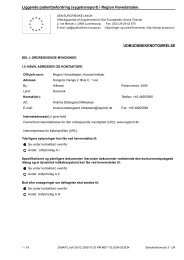Territorial Review Copenhagen - Region Hovedstaden
Territorial Review Copenhagen - Region Hovedstaden
Territorial Review Copenhagen - Region Hovedstaden
Create successful ePaper yourself
Turn your PDF publications into a flip-book with our unique Google optimized e-Paper software.
63<br />
Education and skills<br />
Education outcomes in <strong>Copenhagen</strong> are comparatively weak. This can<br />
be concluded from the OECD/Programme for International Student<br />
Assessment (PISA) study of 2000, which the City of <strong>Copenhagen</strong> conducted<br />
again in 2004 and 2007 for all public schools and for a range of private<br />
schools. The trend for Denmark as a whole is reflected in the scores of<br />
<strong>Copenhagen</strong>: relatively many poorly performing students in all three areas<br />
tested: reading, science and mathematics (Egelund and Rangvid, 2005;<br />
Egelund, 2008). Students in <strong>Copenhagen</strong> score above the national average<br />
when results for immigrant children are excluded, except in mathematics, in<br />
which <strong>Copenhagen</strong> falls slightly below the average. The difference among<br />
schools in <strong>Copenhagen</strong> is significant. Four schools in <strong>Copenhagen</strong> show an<br />
average for reading skills that is above Finland‘s national average (Finland<br />
being the best performer in the PISA study), while 15 schools fall below<br />
Brazil‘s national average (Brazil being the country with the worst<br />
performance). One of the basic problems in post-compulsory education with<br />
a vocational orientation is a lack of apprenticeships (OECD, 2006).<br />
There are large disparities in the performance of Danish and immigrant<br />
students. Immigrant students in <strong>Copenhagen</strong> score approximately 100 scale<br />
points below Danish students on the PISA scale, which means that only 15%<br />
of the Danish students are at a level that is lower than the average for<br />
immigrant students. The performance of immigrant students is particularly<br />
weak in science. The share of Danish students without functional reading<br />
skills in the PISA study was 18%. In <strong>Copenhagen</strong>, the figure is 24%, with<br />
14% of Danish students and 51% of immigrant students showing poor<br />
reading skills. Differences in socio-economic status account for only 50% of<br />
the ethnic test score gap. Differences between schools account for a<br />
substantial additional portion of the ethnic gap (about 30% for reading<br />
scores and somewhat less for mathematics and science). The performance of<br />
immigrant students could therefore be linked to ethnic segregation at school<br />
level. Despite comparatively low income segregation, ethnic segregation in<br />
<strong>Copenhagen</strong>‘s schools comes close to the high segregation levels of many<br />
US cities. Today, almost 30% of all students attend schools that can be<br />
classified as almost all native-born Danish – and one out of five students<br />
attends school with a majority of immigrant students. Only a minor part of<br />
this can be explained by differences in socio-economic background<br />
(Rangvid, 2006).<br />
Educational segregation might have an impact on dropout rates of<br />
immigrant students. Children of immigrants enter upper secondary<br />
education at almost the same rate as those of Danish origin. The lower<br />
attainment level is mainly attributable to higher dropout rates among<br />
children of immigrants. The dropout rate of immigrants from vocational

















